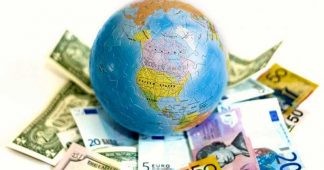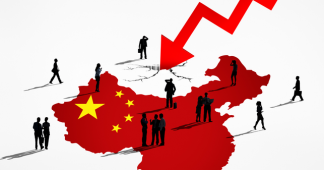By Nick Beams
21 December 2019
World Bank research has pointed to a global wave of debt since 2010 that has led to developing countries accumulating a “towering” $55 trillion of debt—the largest in history.
The analysis is contained in a book-length report Global Waves of Debt: Causes and Consequences issued earlier this week.
In his foreword to the publication, World Bank president David Malpass noted that “waves of debt accumulation” have been a major feature of the global economy over the past 50 years, with four in emerging and developing economies since 1970.
“The first three waves ended in financial crises—the Latin American debt crisis of the 1980s, the Asian financial crisis of the late 1990s, and the global financial crisis of 2007–2009,” he wrote.
A fourth wave began in 2010 and reached $55 trillion in developing countries at the end of last year, “making it the largest, broadest and fastest growing of the four. While debt financing can help meet urgent needs such as basic infrastructure, much of the current debt wave is taking riskier forms.”
The report pointed out that the present escalation was taking place in conditions of lower growth than prevailed in the period prior to the crisis of 2007–2009. While emerging and developing economies were growing at a slower rate than in the past, their debt levels were rising more rapidly.
Since 2010, debt in developing economies has risen to a total of around 170 percent of their gross domestic product, an increase of 54 percentage points in just eight years.
The report noted that, while developing economies had experienced periods of volatility in the current debt wave, they had not suffered a widespread financial crisis. However, it continued, the “exceptional size, speed and reach of debt accumulation” wer cause for concern.
“Despite the sharp rise in debt, these economies have experienced a decade of repeated growth disappointments and are now facing weaker growth prospects in a fragile global economy. In addition to the rapid debt build-up, they have accumulated other vulnerabilities, such as growing fiscal and current account deficits and a shift towards a riskier composition of debt.”
Previous waves were largely regional in nature but the fourth wave has been widespread with total debt rising in 80 percent of emerging market and developing economies, increasing by at least 20 percentage points of GDP in just over a third of these economies.
The report warned that on a number of measures, developing economies were in a worse position than before the global financial crisis. Three-quarters had budget deficits, corporate debt denominated in foreign currencies was much higher, and current account deficits were four times larger than in 2007.
This meant that despite exceptionally low interest rates and the prospect of continued low rates in the near term, “the current wave of debt accumulation could follow the historical pattern and culminate in financial crises.”
The largest increase in debt is in China where the debt-to-GDP ratio has risen by 72 points to 255 percent since 2010. This is the result of measures initiated by the government and financial authorities to sustain economic growth in the wake of the global financial crisis and recession.
The Chinese government is now trying to rein in debt accumulation. At the same time it is seeking to maintain economic growth under conditions where the increase in GDP is at its lowest level in 30 years.
Earlier this week, Bloomberg reported on an interview given by Ma Jun, an external adviser to the People’s Bank of China, in which he called for measures to prevent “systemic risks” resulting from the failure of local government borrowing platforms. He warned of a “chain reaction” if defaults damaged market confidence and said local government borrowing vehicles should be allowed to take over their weaker counterparts, including those in other provinces. Local government borrowing, particularly to finance infrastructure programs, plays a vital role in maintaining the growth of the Chinese economy.
The rise of corporate debt in China is also of increasing concern. In the last eight years, corporate debt as a percentage of GDP has increased by more than 60 points.
A Reuters report noted that increased debt is generating smaller increases in production than in the past. This is reflected in a three-fold increase in the Incremental Capital Output Ratio from 2009 top 2017.
“In other words,” the report said, “China’s credit-heavy financing spree was not matched by a corresponding boost in productivity, but by an increasingly inefficient use of credit, which suggests China’s corporations may have a deteriorating capacity to repay their existing debts.”
It cited a finding by the International Monetary Fund in which it estimated that 15.5 percent of all commercial bank loans to the Chinese corporate sector were “at risk,” meaning that the firm’s earnings were not sufficient to cover the interest payments on its loans.
The growing problems in the Chinese corporate sector have been highlighted by a series of defaults and near defaults in Shandong province. Over the past three months, six privately-owned companies have either defaulted or come close to defaulting on debts totalling $9.7 billion.
Shandong is China’s third-richest province but in the past year its economy has markedly slowed. Industrial profits in October were down 15.5 percent compared to the previous year and its growth rate dropped to 5.4 percent in the first nine months of this year—one of the lowest levels in the country.
The financial problems of individual corporations in the province are compounded by the arrangements between them in which one company comes to the aid of another if it runs into difficulties. While this system provides for stability under conditions of overall expansion, it risks spreading instability if the economy turns down.
Commenting on the Shandong defaults, the Financial Times said the distress had “become harbinger for financial risk across the country.” It cited a report by Fitch Ratings that due to a “wave of defaults” on corporate bonds, the Chinese private sector default rate had risen to a record 4.9 percent at the end of November, compared to 0.6 percent in 2014.
Published at https://www.wsws.org/en/articles/2019/12/21/debt-d21.html











